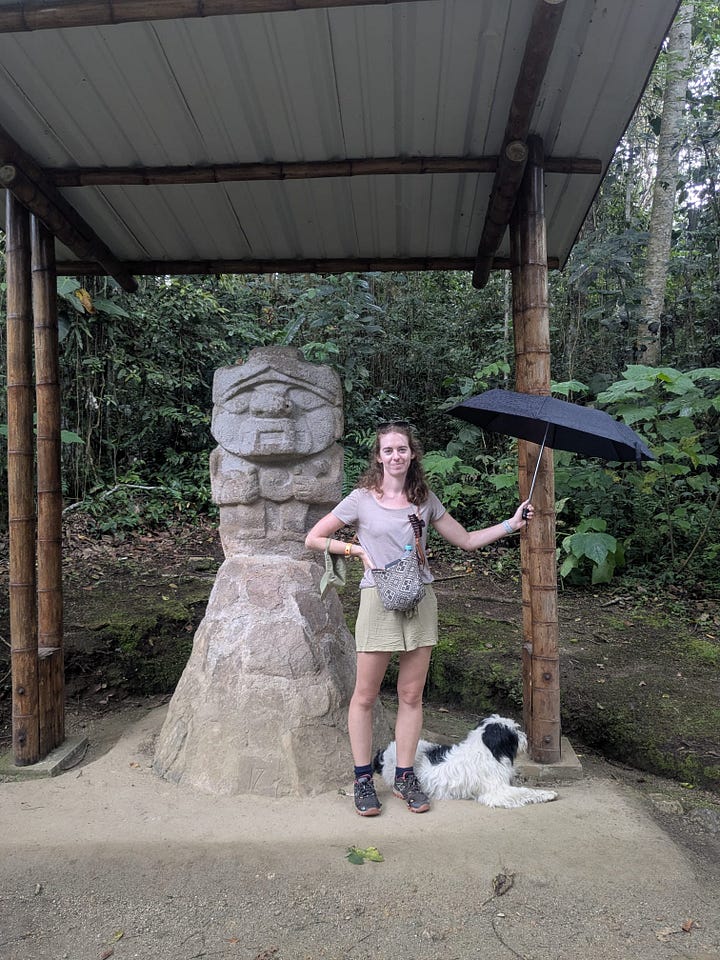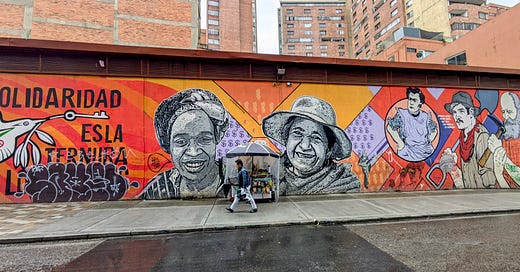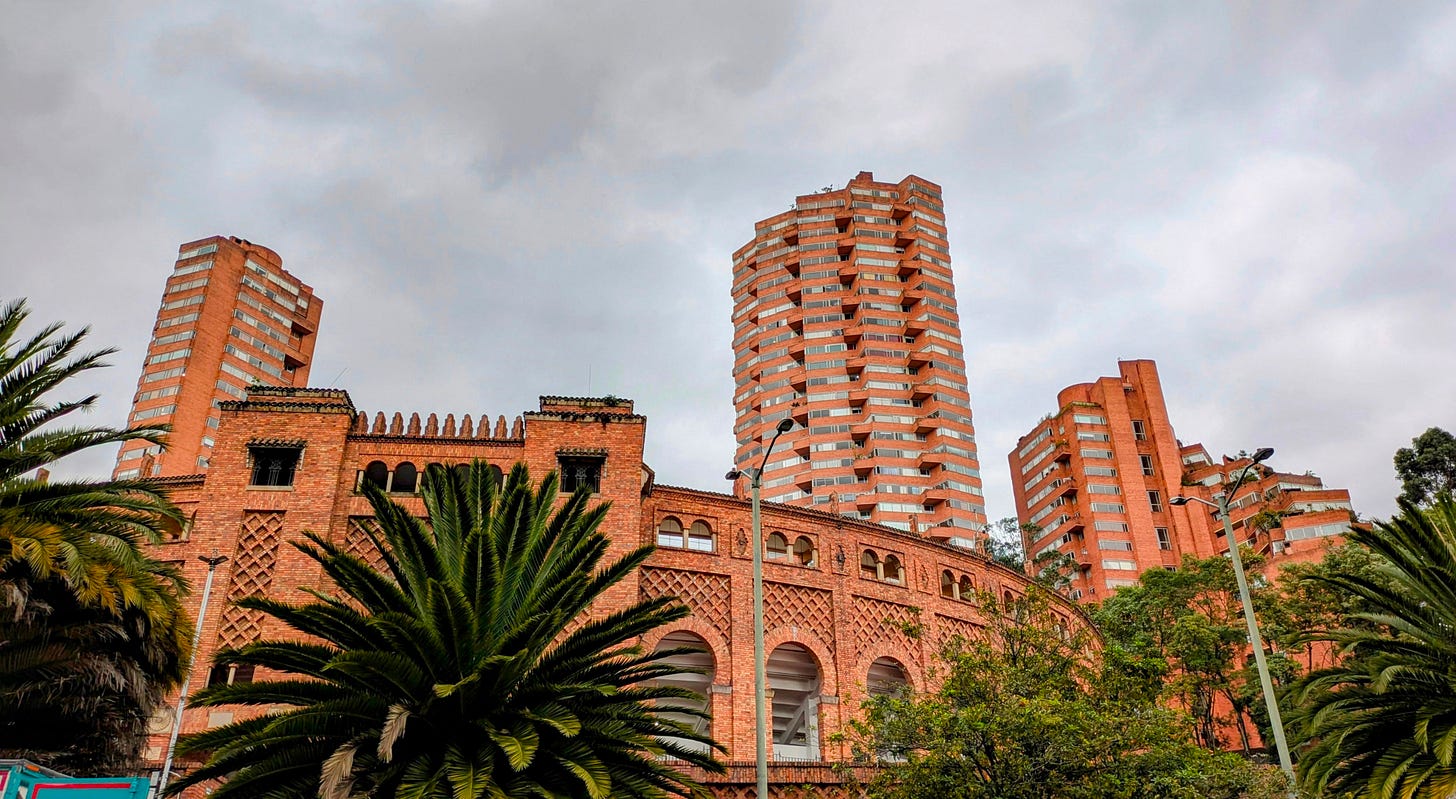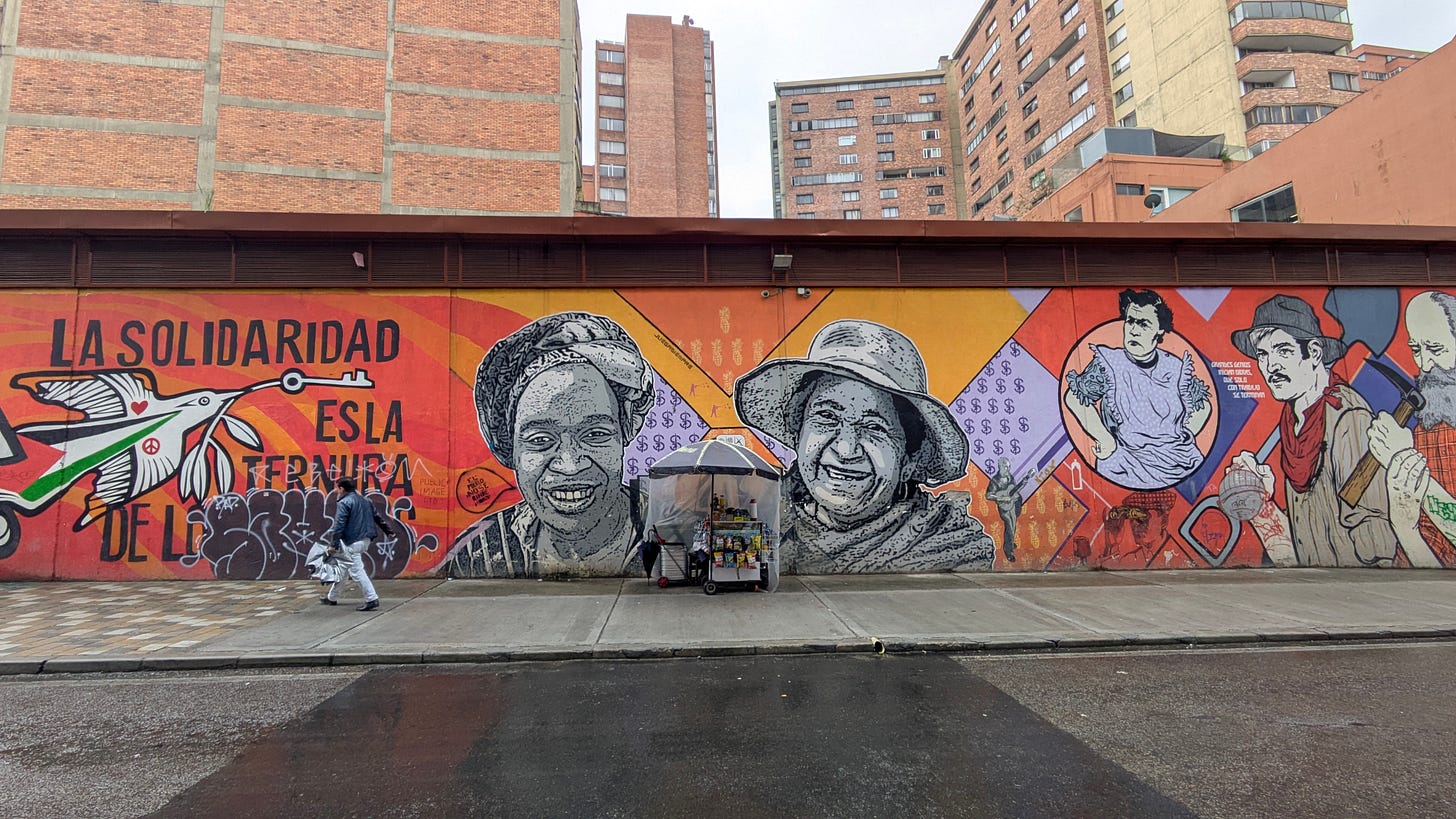Six years late, I finally made it to Colombia
One week in the country and we're already being offered the "special" tour...
The last staff job I had before I went freelance was at Times Higher Education magazine. It was a great place to work, for the most part: everyone in our small editorial team was lovely; I liked my split beat, writing stories about the life of academic researchers and about higher education issues in Latin America; and I enjoyed travelling to far-flung cities for the magazine’s many international conferences, when the chance came.
But even with the promise of those trips keeping me going through the duller moments and stressful deadlines, it was never enough to keep my full attention, and I’m sure my colleagues knew it. When I nervously asked to meet with my line manager to hand in my notice, I explained that I wanted to try my hand at freelancing and expand my writing remit away from the confines of higher education. Chris nodded, but didn’t respond straight away. He was still looking at me expectantly, as if to say, “And..?”
“…And also I want to go travelling around South America for a year,” I blurted. This, we could both compute – I think Chris always knew the travel itch would get to me one day. And the admission of my half-formed plan suddenly made it very real.
Over the following weeks in the office, while I worked through my notice period, rumours of my Going Travelling had morphed into Moving to Colombia, and I didn’t bother to correct anyone on it. I think in the same way it helped Chris to have an external factor to blame for my leaving the magazine (travel, rather than, say, my very stagnant salary…) it sounded more official and somehow justifiable to my more sensible, hard working colleagues – the image of me starting a different life on the other side of the world, that I was not just an overgrown student going hostel-hopping for a year.
That was 2019, and I didn’t make it to Colombia the following year as planned. Our whole trip was delayed due to Covid, of course, and by the time we did get going in October 2023, our plans and projected route had completely changed too.
So it feels quite poignant that Dave and I are now finally in Colombia, almost six years later than billed. Instead of being one of the first countries on our itinerary as per our previous plan, it is the 12th and last country we will visit (for now) on the South American continent (alas, Venezuela, I will come back for you when you’re ready). And my initial impressions upon wandering around Bogotá were: yes, I could imagine myself living here.
Bogotá is cool. Not everyone thinks so, but I say so. It has a reputation for being Colombia’s less vibrant city, possibly because the weather is much cooler there, being up in the Andes, so you don’t get the same outdoors culture and party vibe as Cartagena, Medellín or Cali. But there’s still plenty of culture to be had. La Candelaria, ie, the old city centre is beautiful – you’ve got the Plaza de Bolivar with its houses of congress and other huge, stone buildings, and you’ve got all the cute little cobbled streets with whitewashed buildings stemming off it. The majority of the city isn’t so classically beautiful, but it is striking – most of the city is made up of red-brick high rises that to me made it feel a little like New York.
It’s not overrun with tourists, and more than anything else it just feels like a very liveable city. The morning we arrived was a Sunday, and we noticed that the entire ring road and a lot of the main roads in and around the city were closed to cars and effectively turned into an enormous dog park/cycle path/running track situation. They close actual motorways every week so that people can stroll with their dogs down the equivalent of the M25 just for fun! Imagine! It’s mad to see, but clearly super popular as a weekend activity among cyclists, runners, walkers, families and friends just hanging out.
When Dave and I emerged from our four-week escapade through the Guyanas – feeling exhausted and much poorer, glad to be back in Brazil – the first thing on our to-do list was pay our outstanding visa fines. Brazil is so dizzyingly huge and fun that we didn’t notice we’d outstayed our 90-day tourist visas until we were both way overdue – me by a week and Dave by almost four, having spent a strange and solitary two weeks in Londrina while I zipped back for a wedding – and we’d been told to pay the staggering respective charges of £13.75 and £14.50 upon our return to the country.
Arriving at the Guyana-Brazil border from Lethem, we gave the immigration officers on duty a bit of a shock – both had their headphones on, watching TV on their phones, they clearly didn’t get much foreign traffic through this particular gate – and the additional discovery that we had unclean records attached to our passports created a bit of angst off the bat. Each border guard took turns to read our disciplinary letters (RE: outstayed visas) and scratched their heads for a bit. I explained that we were coming back in part to pay the outstanding fines, and that we only needed about four days more in Brazil because we’d soon be leaving for Colombia. One of the guys stamped us for another 90 days and wagged a finger, telling us to go straight to the bank to pay the fines – but not until we’d had some lunch, of course. Then he backtracked some more: “Just pay the fines before you leave Brazil, ok?”
We’d initially planned to spend a night in a city called Boa Vista, between Lethem and Manaus, partly to factor in time for delays and because we’d had no idea how long it would take us to get from Iwokrama out to Brazil on our last day in Guyana. As it happened, we got to Boa Vista in good time but found it undeniably bleak – wide, empty roads and concrete shells of abandoned building projects; not a huge amount going on in the city centre by any estimations. It was hot, as it had been in Guyana, but this heat was arid, which is bizarre for the region. We read that the government had effectively cleared out the rainforest decades before to build this town, which had transformed the climate irrevocably into a lifeless desert. As I said, a bit bleak. There was an overnight bus that would take us on to Manaus and that seemed like a much better bet.
It felt good to be back in Manaus, this city I hadn’t thought a huge amount of the first time around, but now, on round three, it felt friendly and familiar, busy and colourful in a nice way. And we knew of a great happy hour with very cheap drinks right in the theatre square.
Back in connectivity we were relieved to find that Venezuela, Brazil and Colombia had not all gone to war in the interim, despite our Amazon boat trip host Elso’s educated predictions. But that didn’t change the fact that the Amazon region west of Manaus – right up to the Colombian border – is currently out of bounds for travellers due to threats of piracy and narco gangs operating along the main travel routes (ie, the Amazon river). Elso told us he’d been spooked himself a few months previously, when he and his wife took the boat west (much, much further west than we went) and got chased back by heavily armed river pirates. Clearly, we wouldn’t be taking that risk.
We can’t travel through Venezuela yet (even though so many people we meet insist it is much safer now, the UK foreign office still advises against all travel) and strangely, you can’t fly from Guyana straight to Colombia either. So we’d made our way back to Manaus to catch a flight from there instead – it was the best we could do for the lowest price and smallest distance.
To save money on the flight, we’d opted for the most gruelling time possible (classic us) – leaving around 3am from Manaus airport, arriving in Bogotá still very early and one timezone behind. We’d treated ourselves to a fancy-looking hotel in the posh end of the city as a reward for all the hassle, but any hopes that they might let us check in early were dashed and so we spent a lot of the day waiting in cafes, trying not to fall asleep after some 30 hours of consciousness – a process we were well accustomed to from taking so many night buses.
We took a graffiti tour of the city (a fun alternative to the classic tips-based city walking tours), and learned that graffiti has been legal in public spaces like parks in Colombia since 2011 – a change that came about after a young boy was shot dead by police when they caught him spray painting in an underpass. Later, we visited the Museo del Oro (loads and loads of gold) and Museo Botero (which includes galleries dedicated to the works of Fernando Botero and his excellent, chubby horses), but mostly we ate and drank really good food, beers and wine.
Long-time readers will know Dave and I have endured some seriously long bus rides on this trip and we're used to things not arriving when they say they will. But the overnight bus from Bogotá to San Agustín took this to a whole new level. We expected to arrive at 7am, and when I woke up to find us still on the road at 7.30 I was glad for the extra sleep. But then the bus stopped, and we didn't move again for four hours.
The road was at a standstill. Crucially, we hadn't eaten in a very long time. I hopped off the bus and saw our driver was gone, as were all the other drivers – there was no way we'd be moving any time soon. Luckily, Colombians are an entrepreneurial bunch and some locals with motorbikes were using the opportunity to dash backwards and forwards selling homemade arepas and cakes, and as I stood eating one another driver explained the problem to me: the rice farmers were striking over low wholesale prices, he said, but he also believed there was some dispute from farmers over the amount of chemicals polluting the soil from mining elsewhere in the region. It was becoming more difficult and more expensive for them to grow their produce, so every few days in the Huila and Tolima regions, among others, protestors created blockades in the road. This has been happening for years, on and off, and clearly the bus company knew it would be the case on the day of our travels but had declined to mention it. I feel like they could have at least given us a heads up that the bathroom break we took earlier that morning would be the last one for many more hours.
It was frustrating not knowing how long we’d be stuck for, but ultimately when you’re on a 12-hour bus, what’s a few more hours anyway? We walked up the road trying to see if we could spy the end of the queue of vehicles but failed – several kilometres of trucks, cars and buses as far as the eye could see. We dozed. We read our books. We ate one dry motorbike arepa each. Finally, we arrived in San Agustín 20 hours after leaving Bogotá – ten later than expected. But it was fine – no drama, and no aggro between the police and the protestors that we could see, or the road users, for that matter. Just another day in Colombia.


We had come to San Agustín to see a bit of the south and more specifically some very funky old statues. Our hostel was cute, cheap, and comfortable, but better still, the people who ran it also offered horse riding tours of the valley, which included the chance to see some bonus old statues along route. In other words, both Dave and I could satisfy our respective hobbies: Dave’s being Old Stuff and mine being Laughing at Dave Being Unable to Control a Horse. It was unfortunate for him that the past two or three times we’ve ridden horses somewhere, I’ve been assigned some sprightly thing called Shakira, Esmeralda or Zorro – while Dave’s been handed over to some absolute joker with a taste for danger and a name like aquel-que-no-se-deja-llevar-por-la-voluntad-de-los-dioses – or something else unpronounceable. And his horses always know that this is a guy with zero authority.
It happened that my horse, Zorro, liked to lead the group (there’s always one) and was also very excited to canter up and down the hills, putting on little bursts of speed at random. For me, this was fun and not a problem. It didn’t bother our horseman, Carlos, either, because he was keen to speed up our progress and show us the sights before his 11.30am lunch plans. It still warms my heart to remember the way he encouraged our horses along, calling out “vamos, mi hijos!” – let’s go, my children! And it still absolutely cracks me up to remember the look on Dave’s face when his horse tore off after mine at full pelt down the hill. Dave’s first full trot, and immediately afterwards, Dave’s first canter and Dave’s first gallop.


There are absolutely hundreds of ancient statues hanging out around San Agustín, which is itself a very cute and charming town of whitewashed colonial buildings and views across a valley. They range from humanistic to distinctly penguin in style but are generally all carved into single, large and quite square pieces of stone. They’re quite hard to describe without pictures (so here are some to help) but some people have likened them to the Rapa Nui/ Easter Island statues and I can see it a bit. Nobody really knows their significance or their exact age, but the general consensus is that they’re meant to represent sacrifices, gods, guardians of graves and supernatural entities (ie, penguin gods). The research is clearly still in its early days, as was clear from the very vague museum descriptions we read, but some of the statues have been dated back as far as 3,300BC(!). Super old. Oh, and there are more than 600 of them – so far.
Some years ago the state gathered up the majority of the uncovered statues and popped them in a designated park to keep them protected and show them off to visitors. But there are more statues being discovered all the time, by farmers digging their land or sometimes just in local peoples’ back gardens – so there are lots of less official, mini sites you can visit by paying the landowner a small fee. It was one of these farm discoveries Dave and I were off to see with Carlos and the caballos. And they were amazing – in the archaeological park the statues are largely out in the elements and the colours have completely faded over time, but these ones had somehow been so well protected from the elements that the bright blue, yellow and red paint (made from berries and tree sap) was still very visible.
Carlos gave us some of the history of the place. The first excavations of the statues took place in 1910 (although it’s thought that some were raided from tombs back in the 17th century) but it wasn’t until 1993 that the area was designated a protected historic site and archaeological park. The colourful sculptures were only discovered a few years ago. It was interesting to chat to Carlos about how much the discovery of the statues had changed the town – and local fortunes. And then he turned to me and asked if we fancied going to the local cocaine factory to see how cocaine is made.
We were talking in Spanish – humble brag, maybe it goes without saying, but not so many people in Colombia speak English – and it took me a little moment to register what Carlos had said and make sure I wasn’t mistaken, that he wasn’t just chatting coca leaves. But no, apparently this was the “special tour” not advertised through the public channels. It wasn’t his laboratory, he (and now I) hastened to add, but like a lot of places in Colombia there was a small local group producing the stuff from the abundance of coca plants growing nearby (plus all the petrol, etc) and they were very jolly and happy to welcome visitors for a hefty fee.
Supposedly, a group of Americans had paid one million Colombian pesos for the experience ($237 or £180-ish) but Carlos would take us for a cool $300,000 (Colombian): What did we reckon? I stalled by asking him questions about it all. Did he think it was ethical to support that kind of business? Dave and I were about mid-way through Narcos season one at this point and that felt like enough of an education. But you don’t need to spend long in Colombia to hear stories about the 80s and 90s drug trade and all the violence it led to. Carlos chose not to overthink it all: these weren’t narco heavies, they were just local guys trying to make a living in a tough economy, like anyone else.
I’d be lying if I said I didn’t consider the opportunity. Would it make me a bad journalist if I didn’t go? And I believed what Carlos was saying, that these were local guys, that it wasn’t dangerous; that the police were totally aware of their business and all the other micro laboratories, but it was probably too small fry for them to care. Ultimately, the offer still felt too grubby. Neither of us wanted to contribute to an industry associated with so much violence, however small our contribution might be. We politely declined the invitation and went back to galloping through the mountains in search of more mysterious ancient penguins.
Travel bits and tips from this week:
Back in Manaus, we stayed for a third time at the cheap and cheerful Farol da Barra Hotel, and enjoyed affordable drinks and meals once again at Tambaqui de Banda and Pizzaria Splash. The Skina dos Sucos juice bar is also a must.
We also took a little day trip out to Reserva Florestal Adolpho Ducke, a nature reserve on the edge of the city where the jungle begins. It was no comparison to the real thing, obviously, but it was really lovely to walk around, spotting monkeys and scarlet macaws, and well designed for families and people who might not be able to go out on a full tour to the rainforest proper.
In Bogotá we visited the Museo del Oro (said to house the biggest collection [stolen] gold in the Americas), followed by Museo Botero in the Banco de la Republica building. It’s free to visit between 3 and 5pm on Wednesdays but I’m sure we visited more than once and never paid…
We had an excellent vegetarian menu del dia at Quinua Y Amaranto in La Candelaria, stuffed ourselves with pastries from El cometa bakery and La Mata Coffee Place Fresco, and found good ramen at Ko Asian Kitchen.
There was also Enchiladas La Candelaria, Negroni Ristorante; we splashed out on a tasting menu at Humo Negro (wins lots of awards) and had great mexican food at
Dos Gatos Y Simone.
In San Agustín our horse riding tour took us to see La Chaquira, where statues were found carved into boulders overlooking the canyon, and El Purutal, which is home to two colourful and well preserved sculptures.
The Parque Arqueológico de San Agustín is a great day out, too. There are resident dogs who will guide you through a forest route past all the statues and then stare creepily at them as if communicating with their ancestors.
In San Agustín we had good veggie food at La Loceria and Tomate Restaurante Vegetariano and good burgers (veggie and non-veggie) a La Gata Parilla.
Big claim, but the most disastrous meal of our trip took place at TINGO TANGO - LA MOLIENDA… Siabatto Pasta & Vino saved us.







